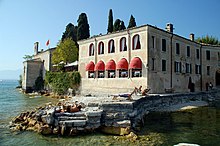Punta San Vigilio
The Punta San Vigilio is a small headland on Lake Garda between Garda and Torri del Benaco at the foot of Monte Baldo and protrudes furthest out into the lake after the Sirmione peninsula . The Punta, Italian for point or point, today consists of the Villa Guarienti di Brenzone, the Locanda San Vigilio with a church of the same name and a small harbor with a café . In the north there is the Baia delle Sirene (Bay of the Sirens ), which is considered to be the most beautiful bathing bay in the whole lake.
history
The oldest surviving structure on the peninsula is the small church of San Vigilio from the 13th century, dedicated to St. Vigilius of Trento and who gave the Punta its name. At the end of the Middle Ages there was an inn and a small port next to it.
In 1540, the humanist Agostino di Brenzone, doctor of both rights and member of a patrician family from Verona , acquired the peninsula and had an architectural synthesis of the arts created from landscape and buildings in the classical style. For the implementation, di Brenzone was able to win over the well-known fortress builder Michele Sanmicheli , who included the old buildings with church and port in his planning.
A cypress avenue , which is still preserved today, was laid to the highest point of the peninsula. There the Villa Brenzone was built , which is now owned by the family of Count Guarienti di Brenzone. The villa was surrounded by a large Renaissance garden, which descends in terraces towards the lake and offers the best views of Lake Garda. The port was expanded with a guest house, the Locanda di San Vigilio . Today a hotel with a restaurant is housed in this building complex . You finally enter the harbor area through a gate. On the other hand, no structures were built towards the bay to the north, but olive trees were planted on the slope towards the lake.
Agostino di Brenzone was so enthusiastic about his creation that he wrote:
“Neptunus mare deseruit subducere tentrans Benaci imperium.”
"Even Neptune abandoned the sea, trying to wrest power from Benacus."
Here he met his friend Pietro Aretino and other writers and artists of the time for a scholarly discussion in beauty and sublimity. The famous deduction about the most beautiful place in the world also comes from him . In a letter to Silvano Cattaneo he wrote:
“I want Your Excellency to note that San Vigilio is the most beautiful place in the world, and it does so in the following way: The whole world is made up of three parts: Africa, Asia and Europe. The most beautiful part of the world is Europe, of which Italy is the most beautiful part, of Italy again Lombardy, and of this Lake Garda, and on this one San Vigilio. Ergo, San Vigilio is the most beautiful place in the world. "
Marie-Louise of Austria , Napoleon's 2nd wife , Tsar Alexander III , stayed in the Villa Brenzone and Locanda San Vigilio, which used to be the villa's guest house . , Winston Churchill , Laurence Olivier and Vivien Leigh .
In March 1913 Otto Hahn and his wife, the painter Edith Junghans , spent their honeymoon here. A marble tablet made by Massimo Ragnolini, unveiled in 1983 by Count Guglielmo Guarienti, commemorates this honeymoon. More recently, Prince Charles , King Juan Carlos of Spain and Richard von Weizsäcker were among the guests.
gallery
Punta San Vigilio in art
- The American painter John Singer Sargent (1856–1925) was here in 1913 and made a series of paintings in watercolors and oils .
- The German genre and landscape painter Curt Agthe (1862–1943) also created several paintings of Punta San Vigilio.
- Occasionally it is claimed that the Punta San Vigilio served as a model for Arnold Böcklin's painting Die Toteninsel . However, it has not yet been proven that Böcklin ever visited this place or knew it from descriptions.
- At Punta San Vigilio, crucial parts of the novels garbage novel and Die Liebe in rough features by Bodo Kirchhoff take place .
literature
- Werner Krum: Lake Garda and the Veronese - landscape, art and culture between Trento, Verona and Brescia. 4th edition. Prestel Verlag, Munich 1996, ISBN 9783791316581 , pp. 57-61.
- Walter Pippke, Ida Leinberger: Lake Garda, Verona, Trentino, Mantua: Art and history in the center of the Alpine arc. DuMont, Cologne 2008, ISBN 9783770166176 , pp. 70-72.
Web links
Individual evidence
- ↑ Descrizione di Verona e della sua provincia, Volume 2 (Google Books)
- ↑ Lake Garda: Art and History (Google Books)
Coordinates: 45 ° 34 ′ 25 ″ N , 10 ° 40 ′ 20 ″ E












